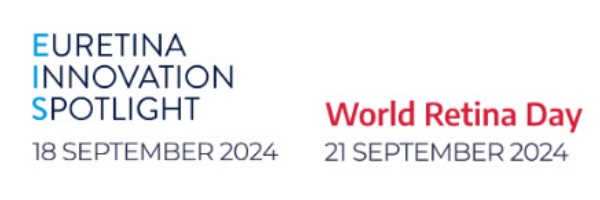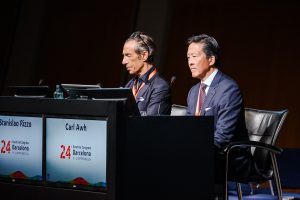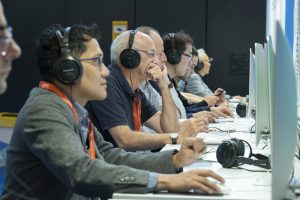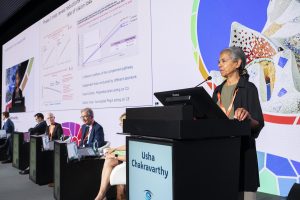As described by its co-moderator, Dr José García Arumí (Spain), Euretina Session 2 focusing on being patient friendly, effective and sustainable in retina practice offered delegates a “different type of session”. Dr Arumí said that the concept for the session came from the late Dr Ramin Tadayoni.
He explained, “Ramin was one of the best surgeons, researchers, and medical doctors, but he had a very sensible touch with patients, and that is why he thought about this session.”
Session co-moderator Dr Adnan Tufail (United Kingdom) added, “There are so many innovations in retina, but this session takes a step back to see what practices that have come on are sustainable and if we are doing things for ourselves or for our patients.”
The topic of sustainability was discussed by Dara Conlon (Ireland), Executive Vice President of Euretina, who shared the steps Euretina has taken to make the annual Congress more sustainable. She said that the journey began in 2018 when the decision was made to eliminate delegate bags that were filled with printed promotional flyers. Then in planning for the Congress in 2022 when there was a return to in-person attendance, Euretina engaged environmental consultants for guidance on sustainability measures.
“Recently we introduced the Euretina sustainability special interest group to help work more actively towards carbon neutrality and joined EyeSustain, a global coalition of eye societies, organisations, and ophthalmologists collaborating to make ophthalmic care and surgery more sustainable,” Ms Conlon said.
She concluded her talk by listing other actions that have been taken as Euretina continues its effort to reduce the carbon footprint of the annual Congress.
Picking up on the theme of sustainability, Dr Jens Kiilgaard (Denmark) discussed the impact that retina practice has on global warming. He presented data on sources of waste and carbon emissions, including intravitreal injections and use of medical gases, along with data on the safety of strategies designed to reduce waste.
Admitting that he does not have solid recommendations to offer, Dr Kiilgaard concluded that there is a clear need for investing more research in this area. He listed some potential strategies and turned to his colleagues for other ideas.
“This is a thoughtful community, and maybe one of you has a great idea that can reduce ophthalmology’s contribution to global warming,” he said.
Other presentations in the session included a talk by Dr Arumí (Spain) who showed a video demonstrating the flow that patients experience when they present for care at the Institute of Ocular Microsurgery (IMO) of Barcelona.
“We fully focus on our patients. We work as a network to offer our patients the most comprehensive diagnosis and the best solutions. Our purpose is quite clear: to lead the way to have an effective and patient friendly practice in eye care and medical excellence accessible through research, prevention, and treatment,” he said.
Dr Tufail followed with a talk addressing the question, “Diabetic screening: can I use AI now?”. After reviewing evidence on this topic, Dr Tufail concluded that the answer is yes, because it has been shown to be effective and able to reduce workload. To some extent, AI screening approaches have also been shown to be patient friendly and sustainable. However, to be most effective it should be done as part of a public health programme, Dr Tufail said.
Patient friendliness and effectiveness were also addressed in a talk by Mr Adam Mapani, a nurse consultant at Moorfields Eye Hospital, who reviewed the UK experience with nurse practitioner injection of intravitreal therapies. In summary, Mr Mapani said that evidence shows the nurse-delivered injections are generally well-tolerated and clinically effective. In addition, this strategy has found acceptance both within the medical community and among patients. However, there are real challenges that need to be addressed regarding staff sustainability and retention.
The session concluded with a talk by Dr Luke Nicholson (UK) who addressed the good and bad of virtual clinics providing remote patient assessment. The focus of his talk was on care of patients with diabetic eye disease.
Registered attendees interested in learning more about making their practices more sustainable, patient friendly and effective can access this session ON DEMAND.
























































































































